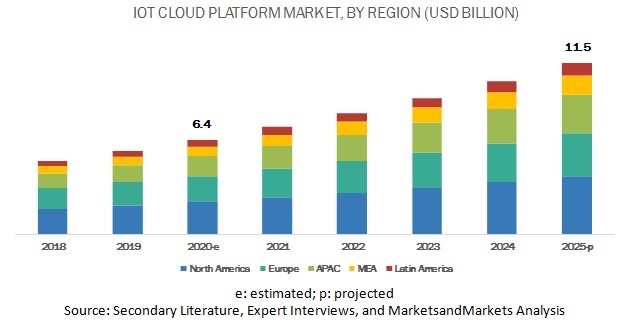Organizations across the globe are increasingly connecting a wide range of IoT endpoints to access data from and handle physical assets associated with their businesses in a better manner. Usual IoT-enabled business objectives comprise conventional advantages like better asset optimization and new business prospects and revenue models, like subscribed-to services. With the growing device connectivity across the globe, the MRFR analysis documents imply that the IoT platform market is projected to grow considerably during the evaluation era from 2022 to 2030 at a healthy growth rate of approximately 15.23%. The reports further project the market to acquire a size of around USD 21.55 Billion by the end of 2030. Let’s take a closer look at these platforms.
IoT Platform: Definition
We can define IoT platforms as a bunch of technologies that offers the building blocks to develop a product. The platform is known to offer the “infrastructure” the user can utilize to make certain solution features. It is a multi-layer technology that is capable of handling and automating connected devices. In other terms, IoT platforms get the physical objects online. The platform will offer user services connecting the gadgets for machine-to-machine interaction. It refers to software connecting the edge hardware, data networks, and access points to the other end, which is normally the end-user application. The primary target of this platform is to offer the users will all the basic functionality for the application so that they can highlight on building various new features distinguishing the solutions from others and add value for the customers. They assist the user in lowering the development costs and risk and boost the product’s time to market by surpassing the non-differentiated functionality. Whenever the discussion on IoT platforms happens, people usually talk about technical jargon such as data lakes, rules engines, transport protocols, etc. While these topics are crucial and deserve a proper strategy, they don’t substantially showcase how they can assist the users. In addition, there are many unknown benefits offered by these platforms.
Based on the streamlined explanation, an efficient platform must offer the infrastructure and tools to cover as many of these tasks as possible. For instance, If the IoT platform is highly robust in analytics but doesn’t assist the user in transporting data from the gadgets to the Cloud, the user is there with a large gap. The user is anticipated to utilize more than one IoT platform in the solution.
The Platforms & Product Policy
Prior to introducing product building and IoT platform selection, the user must ensure that they have a stable IoT product strategy.
A stable IoT product strategy must cover these three areas:
Desirability
Viability
Feasibility
IoT platforms are known to assist the user with feasibility with speeding up and minimizing the threat on the building procedure. The feasibility of the product should be decided after the user’s viability and desirability are known. In other terms, the user must ensure that they are dealing with the true customer discomfort and the solution is likely to cause economic benefits, even before it is built. The user must begin with the UX Decision Area assess Desirability and finish the Data and Business Decision Areas for Viability.
The IoT Platforms & Its Categories
IoT products are known to be highly complicated as they must incorporate several components across the five layers of the IoT technology stack. Considering the difficulty, it is not anticipated that the user will use just one platform covering all areas of the IoT technology stack. Thus, they will require a few distinct kinds of IoT platforms to cover the full spectrum.
Here are some of the popular IoT platform categories:
- Cloud
- IoT connectivity
- Analytics
- IoT device
IoT Cloud Platforms
The type offers the core building blocks for the solution, such as displaying, examining, storing, consuming, and transporting data. As per the name, the main target is to start the rapid development of the application with the help of extraction of the intricacies of constructing of these solutions. There are several IoT platforms available in the market, so finding one to use can be disheartening.
IoT Connectivity Platforms
Connectivity is considered being a vital element of the IoT technology stack, as it helps in connecting on-the-ground IoT devices to Cloud. A few IoT products rely on Wi-Fi connectivity with the Internet. In such cases, connectivity management is already a part of the enablement platform. So, paying the more energy and time in order to make sure the connectivity is expensive. However, products that are elements of critical IoT, like the smart grid, connected cars, or manufacturing equipment, need stronger communication technologies to attain the Internet connection. For instance, several IoT devices depend on cellular technologies such as NB-IoT, 5G, or 4G.
IoT Device Platforms
This category offers hardware building blocks for the development of these devices. It is very crucial the considered the choices available in the market around the world to boost the user’s efforts as they are usually considered being the “long pole in the tent” of the development process. Picking up the appropriate platform as per the requirements is highly reliant on the position of the user in the adoption curve.
IoT Analytics Platforms
The primary target of these products is not only to gather data but also to offer actionable information to the users. Therefore, examining the data is considered more vital than gathering the data. Majority of these type of platforms are known to have multiple analysis tools sufficient for number of applications. But if the application has other requirements including digital twins, visualization, etc., the analytics platform is there to boost-up the development procedure.
Conclusion
Improving these products is highly complicated. By subcontracting non-core aspects of the product to the platform, the user will lower risk, reduce cost, enhance quality, and boost market time. On the last point, if one is considering utilizing an IoT platform, it is definite that the competitors are looking for that too.
